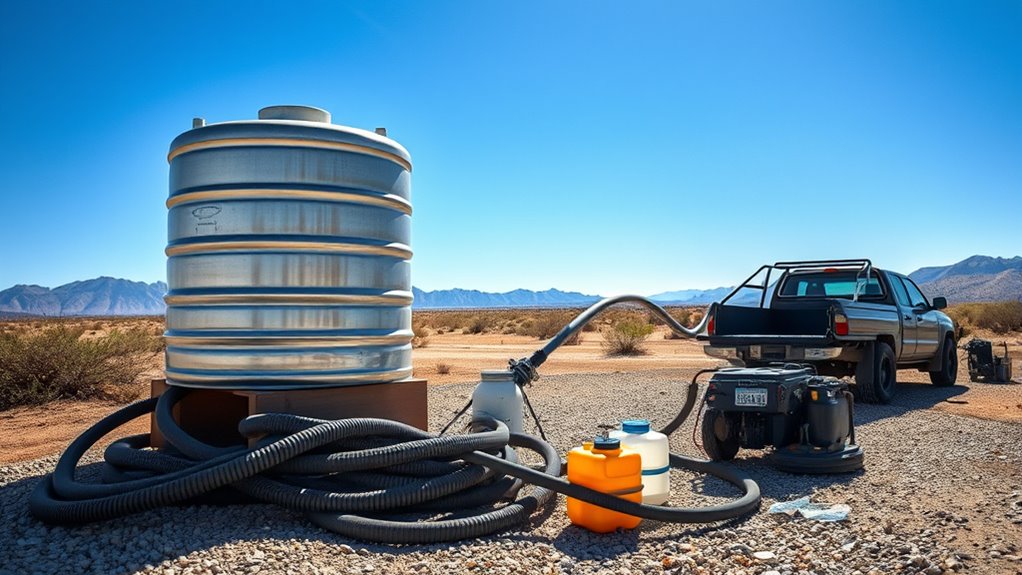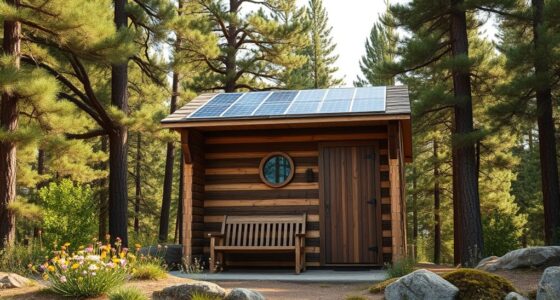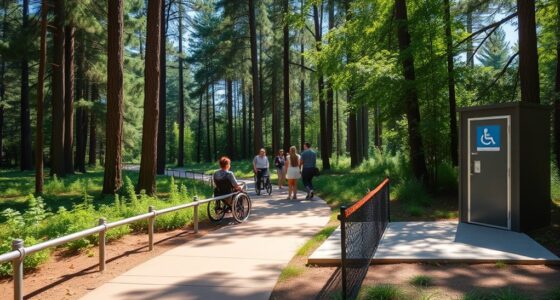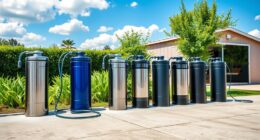To plan water hauling and storage for a remote stay, prioritize installing rainwater harvesting systems with large, properly sealed tanks that suit your needs. Use sturdy, clean containers for transport, guarantee safe and efficient routes, and keep records of usage. Consider backup sources like portable containers or nearby natural water. Regular maintenance and environmental considerations help prevent contamination. To learn more about optimizing your system, keep exploring practical tips and safety measures.
Key Takeaways
- Select appropriately sized, secure storage tanks considering space, water needs, and gravity-fed distribution options.
- Implement rainwater harvesting with clean collection surfaces and proper filtration systems for safe, renewable water sources.
- Use durable, clean containers for water hauling, ensuring proper securing and route planning to prevent spills and optimize trips.
- Incorporate backup supplies like portable containers and identify natural water sources for emergencies and system failures.
- Regularly maintain tanks, filters, and sealing measures, while adhering to environmental guidelines to ensure sustainable and safe water storage.

When planning for water needs, developing a thorough hauling and storage plan is vital to guarantee a reliable supply. In remote locations, you can’t always depend on municipal water sources, so it’s wise to explore sustainable options like rainwater harvesting. Installing a rainwater harvesting system allows you to collect and store rainwater directly from your roof or other surfaces. This method not only reduces the amount of water you need to haul but also provides a renewable resource that can supplement your supply. Make certain your collection surfaces are clean and suitable for water catchment to maximize efficiency. Once collected, the rainwater should pass through water filtration systems to guarantee it’s safe for drinking, cooking, and other household uses. These filtration systems remove debris, bacteria, and other contaminants, making rainwater a reliable and eco-friendly option.
A solid storage plan is equally important. You’ll need appropriately sized tanks that can hold enough water for your entire stay, especially during dry spells. Consider the space available and the volume of water you’ll need daily. Elevated tanks can help with gravity-fed distribution, reducing the reliance on pumps and power sources. It’s also essential to set up a regular maintenance schedule to check for leaks, sediment build-up, and filter cleanliness. Proper sealing and covering of tanks prevent mosquito breeding and contamination from external sources. When hauling water, always prioritize safety. Use sturdy, clean containers and secure them properly in your vehicle to prevent spills and accidents.
To maximize efficiency, plan your water hauling routes to minimize trips and fuel use. Combine errands or water needs with other supplies to save time and energy. Keep a record of water usage to help you predict future needs more accurately, adjusting your rainwater harvesting system or storage capacity as necessary. Incorporate backup options, such as portable water containers or nearby natural water sources, in case of system failure or unexpected droughts. Additionally, understanding Louisiana alimony laws and court considerations can aid in financial planning related to water costs and resource management.
Finally, educate yourself on the local climate and weather patterns. Understanding the seasonal rainfall helps you optimize your rainwater harvesting system and storage capacity. When you combine rainwater harvesting with effective filtration systems and a well-thought-out storage plan, you’ll establish a dependable water supply that supports your remote stay comfortably and sustainably. Proper planning guarantees you’re prepared for various conditions while minimizing environmental impact and reliance on external sources.
Frequently Asked Questions
How Do I Determine My Water Needs for a Remote Stay?
To determine your water needs for a remote stay, start by estimating daily consumption—consider drinking, cooking, and hygiene. Generally, aim for at least a gallon per person per day. Include extra for emergencies, like water purification in case your supply runs low. Calculate the total by multiplying your daily needs by the number of days you’ll stay. Always carry an emergency water supply to stay prepared for unexpected situations.
What Are the Best Types of Containers for Water Storage?
Your water storage needs are critical, so choose containers that are virtually indestructible. High-quality polyethylene or stainless steel are your best bets—they’re known for exceptional durability and can withstand the rigors of remote stays. Confirm they’re made from food-grade materials to guarantee safety and prevent chemical leaching. These containers keep your water pure and safe, providing peace of mind and reliable access, even in the most challenging environments.
How Often Should I Refill or Inspect My Water Supply?
You should inspect your water supply weekly to guarantee water quality remains high and containers stay clean. Refill your storage when water starts to look or smell off, typically every 1-2 months, depending on usage. Regular container maintenance, like cleaning and sanitizing, prevents bacteria buildup. Staying vigilant with inspections and refilling helps keep your water safe and fresh during remote stays, ensuring you always have access to clean water when needed.
Are There Eco-Friendly Options for Water Hauling?
You might think eco-friendly water hauling options are limited, but sustainable sourcing and biodegradable containers prove otherwise. Using locally sourced water reduces transportation emissions, while biodegradable containers minimize plastic waste. These options are practical and environmentally responsible, helping you lower your carbon footprint during remote stays. Choosing eco-conscious methods guarantees you protect nature while enjoying your time off, making your water hauling more sustainable and less harmful to the environment.
What Safety Precautions Should I Take During Water Transport?
To guarantee safe water transport, always check water quality before hauling to prevent contamination. Secure your containers properly to avoid leaks or spills during transport. Use appropriate containers designed for water, and avoid overfilling. Drive carefully to maintain transport safety, especially on rough roads. Regularly inspect your setup for leaks or damage. Properly label your containers, and keep emergency supplies nearby in case of accidents.
Conclusion
Now that you have a solid water hauling and storage plan, you’re practically prepared for anything nature throws your way. With enough water to last through the wildest adventures, you’ll stay refreshed and ready, no matter how remote your stay. Remember, the right setup can make you unstoppable—like having your own personal oasis in the middle of nowhere. Stay smart, stay stocked, and embrace the freedom of truly self-sufficient outdoor living!









